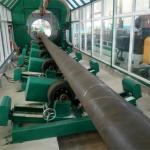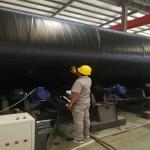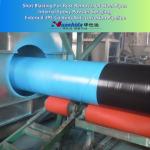External FBE Coating Equipment,Maneuverable PP Coating Equipment
For Steel Pipe
INTRODUCTION
3PE anti-corrosion pipeline with three-layer PE anti-corrosion
structure
First layer: epoxy powder (FBE>100um),
Second layer: Adhesive (AD) 170-250um,
Third layer: Polyethylene (PE) 2.5-3.7mm
The three materials are integrated and firmly bonded with the steel
pipe to form an excellent anti-corrosion layer. The pipe diameter
range is between 60 and 2820, and the wall thickness range is
between 2.5-18mm. This is a good anti-corrosion method that can
generally increase the service life by 50 years. It not only
extends the replacement cycle of underground pipeline equipment,
but also greatly saves costs, providing a strong role in national
construction!
3PE anti-corrosion steel pipe base materials include seamless steel
pipes, spiral steel pipes, and straight seam steel pipes. The
three-layer polyethylene (3PE) anti-corrosion coating has been
widely used in the water supply, natural gas, and petroleum
pipeline industries due to its excellent corrosion resistance,
water vapor permeability, and mechanical properties.
Description:
3PE anti-corrosion coating production line means the steel pipe is
protected by three layer to prolong the life of use from 5-10years
to 50-100years.
First layer is Fusion bonded epoxy layer (FBE> 100µm), the
second layer of adhesive (AD) 170 ~ 250µm, the third layer of
polyethylene (PE) 2.5 ~ 3.7mm. Present we can made the machinery
for diameter range Φ159 ~ Φ1220.
3PE steel pipe outer coating has a high mechanical strength,
excellent electrical insulation performance. The merits include
high degree of mechanization, process parameters stable, not
pollute the environment, etc. In recent years, the intensive of the
pipeline corrosion engineering has been widely used.
Specific process description:
1.The bare pipe to be produced is lifted by a crane to the bare
pipe entry platform, and the surface is cleaned of sediment and
dirt, and the welds are inspected for defects. After passing the
preliminary inspection, the bare pipe to be shot blasted and
derusted is transported to the central axis of the spiral conveyor
roller by a hydraulic transverse pipe transport truck, and the
steel pipe is dropped onto the conveyor roller. Under the drive of
the power wheel of the transmission roller, the steel pipe rotates
and moves forward in a straight direction with its head and tail
connected.
2.Under the conveying of the rust removal conveyor, the steel pipe
enters the cleaning room of the outer wall shot blasting rust
removal machine after intermediate frequency preheating. When the
impeller of the shot blasting machine rotates at high speed, the
abrasive (steel shot+multi edge sand mixture) is ejected onto the
outer surface of the steel pipe under the action of large
centrifugal force. The oxide scale and rust layer on the outer
surface of the steel pipe are cleaned under the impact of abrasive
jet, achieving the surface cleanliness specified by the coating
standard. Simultaneously obtaining a certain depth of anchor
pattern to enhance the adhesion of the coating.
3.After completing the outer wall shot blasting and rust removal,
the steel pipe is transported to the lower pipe station. The
hydraulic transverse pipe transport vehicle lifts the steel pipe
off the conveyor roller and transfers it to the inner rust removal
station to blow away the residual dirt inside the pipe. Start the
internal blower and use high-pressure airflow to blow away residual
sand and dirt inside the steel pipe, followed by rust removal
quality inspection.
4. After the rust removal quality inspection of the steel pipe is
qualified, the rotating roller is started to drive the steel pipe
to rotate. According to the production plan and construction
specifications, the pipe end is pasted with masking paper.
| No. | Name | Set |
| A. Derusting Equipment |
| 1 | Pipe-converying Equipment | 1 |
| 2 | Shot Blast Cleaning Machine | 1 |
| 3 | Cyclone Dust Collector | 1 |
| 4 | Pulse dust collector | 1 |
| 5 | Centrifugal exhaust fan | 1 |
| 6 | Rust removal equipment PLC | 1 |
| B. Coating equipment |
| 1 | Coating transfer equipment | 1 |
| 2 | IF heating device | 1 |
| 3 | Powder spraying device | 1 |
| 4 | Automatic loading dryer | 2 |
| 5 | SJ-65/30 Extruder | 1 |
| 6 | SJ-180/30 Extruder | 1 |
| 7 | Hot melt adhesive extruder die | 1 |
| 8 | PE sheet extruder head mold | 1 |
| 9 | Hot melt adhesive/PE sheet coating device | 1 |
| 10 | Environmental Protection Ventilation equipment | 1 |
| 11 | Cooling Spray equipment | 1 |
| C.Platform Equipment |
| 1 | Steel pipe platform | 1 |
| 2 | Post-rust removal transition platform | 1 |
| 3 | Product tube storage platform | 1 |
| 4 | Hydraulic Equipment | 3 |
| D.Groove Equipment |
| 1 | PE Beveling Machine | 2 |
| 2 | Hydraulic Lifting and Turning Machinery | 1 |
| 3 | Hydraulic Equipment | 1 |
| 4 | PLC | 1 |
| E.Compressed air Equipment |
| 1 | Screw Air Compressor | 1 |
| 2 | Cold dry machine | 1 |
| 3 | Precision filters | 3 |
| 4 | Gas tanks | 1 |
The technological processes employed by Huashida Machinery for the
3LPE coating of steel pipes involve a series of meticulous steps
designed to ensure the highest level of quality and durability.
Here's a detailed overview of the process:
- Upload Pipes:
- The process begins with the loading of the steel pipes onto the
production line. This step ensures that the pipes are positioned
correctly and ready for processing.
- Pipes Screw Conveyor:
- Once loaded, the pipes are transported through the production line
using a screw conveyor. This efficient system gently moves the
pipes forward, allowing for continuous and uninterrupted
processing.
- Rust Removal via Intermediate Frequency Heating:
- To ensure a smooth and even coating, it's crucial to remove any
rust or impurities from the pipe surface. This is achieved through
intermediate frequency heating, which raises the temperature of the
pipe surface to effectively burn off rust and contaminants.
- Epoxy Powder Coating:
- Following rust removal, the pipes are coated with an epoxy powder
primer. This layer acts as a corrosion-resistant barrier, providing
a strong foundation for the subsequent coatings.
- Outer Layer Solidification & Polyethylene Coating:
- Next, the pipes undergo the application of the outer layer, which
consists of a solidified coating and a polyethylene layer. The
solidification process ensures that the coating adheres firmly to
the pipe surface, while the polyethylene layer provides additional
protection against corrosion and wear.









